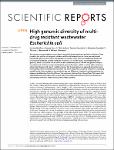High genomic diversity of multi-drug resistant wastewater Escherichia coli
Mahfouz, Norhan
Caucci, Serena
Achatz, Eric
Semmler, Torsten
Guenther, Sebastian
Berendonk, Thomas U.
Schroeder, Michael
Wastewater treatment plants play an important role in the emergence of antibiotic resistance. They provide a hot spot for exchange of resistance within and between species. Here, we analyse and quantify the genomic diversity of the indicator Escherichia coli in a German wastewater treatment plant and we relate it to isolates’ antibiotic resistance. Our results show a surprisingly large pan-genome, which mirrors how rich an environment a treatment plant is. We link the genomic analysis to a phenotypic resistance screen and pinpoint genomic hot spots, which correlate with a resistance phenotype. Besides well-known resistance genes, this forward genomics approach generates many novel genes, which correlated with resistance and which are partly completely unknown. A surprising overall finding of our analyses is that we do not see any difference in resistance and pan genome size between isolates taken from the inflow of the treatment plant and from the outflow. This means that while treatment plants reduce the amount of bacteria released into the environment, they do not reduce the potential for antibiotic resistance of these bacteria.
Files in this item

